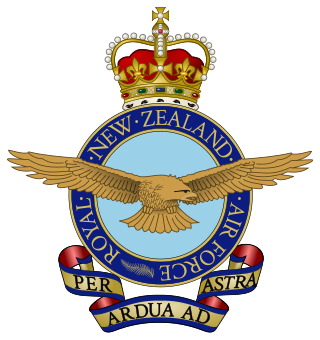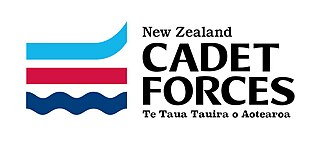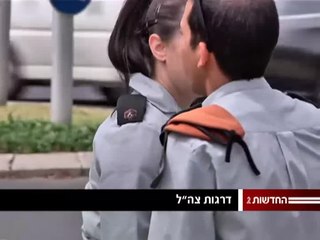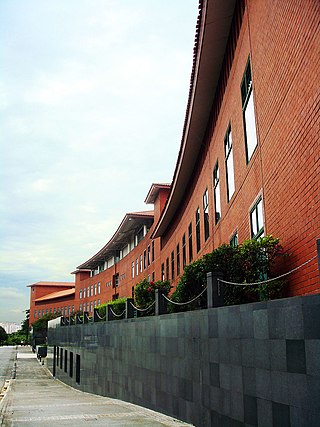
The Royal New Zealand Airforce is the aerial service branch of the New Zealand Defence Force. It was formed from New Zealand elements of the British Royal Air Force, becoming an independent force in 1923, although many RNZAF aircrew continued to serve in the Royal Air Force until the end of the 1940s.
Corporal is a military rank in use in some form by the armed forces of many countries. It is also in use by some police forces or other uniformed organizations. The word is derived from the medieval Italian phrase capo corporale. The rank is usually the lowest ranking non-commissioned officer.
Flying officer is a junior commissioned rank in the Royal Air Force (RAF) and the air forces of many countries which have historical British influence. It is also sometimes used as the English translation of an equivalent rank in countries which have a non-English air force-specific rank structure. In these cases a flying officer usually ranks above pilot officer and immediately below flight lieutenant.

Air commodore is a one-star rank and is an air officer rank which originated in and continues to be used by the Royal Air Force. The rank is also used by the air forces of many countries which have historical British influence such as Zimbabwe, and it is sometimes used as the English translation of an equivalent rank in countries which have a non-English air force-specific rank structure. The name of the rank is always the full phrase; it is never shortened to "commodore", which is a rank in various naval forces.
Under officer is an appointment held by the most senior cadets at some Commonwealth officer training establishments and in University Officers' Training Corps in the United Kingdom, and also a rank used in some Commonwealth cadet forces.
Officer Cadet is a rank held by military cadets during their training to become commissioned officers. In the United Kingdom, the rank is also used by members of University Royal Naval Units, University Officer Training Corps and University Air Squadron; however, these are not trainee officers with many not choosing a career in the armed forces.

The New Zealand Air Training Corps is one of the three corps in the New Zealand Cadet Forces (NZCF), alongside the New Zealand Sea Cadet Corps and the New Zealand Cadet Corps. It is funded in partnership between the Royal New Zealand Air Force (RNZAF) and local communities. Members are civilians with no obligation to enlist in the New Zealand Defence Force (NZDF). Should a cadet enlist, their service in the ATC cadet does not translate into higher pay, rank, or seniority.

The New Zealand Cadet Forces is a voluntary military-style training organisation for New Zealand youth between the ages of 13 and 21. Run in partnership with the New Zealand Defence Force (NZDF) and local community organisations. Through its three branches, the New Zealand Cadet Forces provide young adults with a four-year training curriculum, while a number of local, area, and national camps and courses provide further experience and qualifications. It is jointly funded by the Ministry of Defence, the Royal New Zealand Returned Services' Association, local communities, and the Associated charities belonging to each branch. Overall it is directed by Air Marshal Kevin Short, Chief of Defence Force. Cadets are not under any obligation to join the New Zealand Defence Force, however many choose to do so upon turning 18 years old.
Officer candidate or officer aspirant (OA) is a rank in some militaries of the world that is an appointed position while a person is in training to become an officer. More often than not, an officer candidate was a civilian who applied to join the military directly as an officer. Officer candidates are, therefore, not considered of the same status as enlisted personnel.

RNZAF Base Woodbourne is a base of the Royal New Zealand Air Force, located 8 km west of Blenheim.
The New Zealand Cadet Corps, is one of the three corps in the New Zealand Cadet Forces, the other two being the Air Training Corps, and Sea Cadet Corps. There is no reference to the Army within the official title of the NZCC, but an army theme is used for the NZCC. All of its members, from the cadets themselves to the officers and the support committees are civilian volunteers. Members have no obligation to head into the New Zealand Defence Force (NZDF); however, some do choose to join the NZDF.
The New Zealand Sea Cadet Corps is one of the three corps in the New Zealand Cadet Forces, the other two being the Air Training Corps, and New Zealand Cadet Corps. It is a military-style training organisation for young people between the ages of 13 and 21. Activities include sailing, and boat work, ropework shooting and drill, amongst other activities, many of which involving the other branches of the NZCF. Cadets need to pass an annual swimming test to undertake water-based activities.

The Israel Defense Forces (IDF) has a unique rank structure. Because the IDF is an integrated force, ranks are the same in all services The ranks are derived from those in the paramilitary Haganah, which operated during the Mandate period in order to protect the Yishuv. This is reflected in the slightly compacted rank structure: for instance, the Chief of Staff is seemingly only equivalent to a lieutenant general in other militaries.

Wigram Aerodrome is located in the Christchurch suburb of Sockburn, later to be split-suburb of Wigram and now split again as Wigram Skies. It was gifted by Sir Henry Wigram for the Canterbury (NZ) Aviation Company on 20 September 1916 and originally named Sockburn Airport. In 1923 that was then gifted to the Crown as a Royal New Zealand Air Force base. Charles Kingsford Smith made the first Trans-Tasman flight from Sydney to Wigram on 10 September 1928.
The Royal Air Force Volunteer Reserve (Training Branch), often abbreviated to RAFVR(T), was a Volunteer Reserve element of the Royal Air Force specifically appointed in a cadet training role within the Royal Air Force Volunteer Reserve. Members of the RAFVR(T) had no call-up liability and often operated part-time with the Air Experience Flights and Volunteer Gliding Squadrons, which provide flight experience for the Royal Air Force Air Cadets.

The Australian Air Force Cadets (AAFC), known as the Air Training Corps (AIRTC) until 2001, is a Federal Government funded youth organisation. The parent force of the AAFC is the Royal Australian Air Force (RAAF). Along with the Australian Army Cadets (AAC) and the Australian Navy Cadets (ANC), it is part of the Australian Defence Force Cadets.
Command and Recruit Training Squadron (CRTS) of the Royal New Zealand Air Force is the principal training facility for RNZAF recruits. Located at RNZAF Base Woodbourne, it takes recruits through a thirteen-week training program designed to produce airmen and airwomen for the RNZAF.

The Officer Cadet School (OCS) is a military training centre that trains commissioned officers for the four branches of the Singapore Armed Forces (SAF): the Army, the Navy, the Air Force, and the Digital and Intelligence Service. Located within the SAFTI Military Institute complex in Jurong West, it has twelve wings inclusive of tri-service wings. Nine wings are named according to the NATO phonetic alphabet from A (Alpha) to E (Echo) and S (Sierra) and T (Tango), while the remaining three wings are for the Navy, Air Force, and Digital and Intelligence Service, respectively. The trainees are mostly drawn from the best performing recruits in each basic military training cohort. Trainees with outstanding performance from the Specialist Cadet School (SCS), where specialists are trained, are also invited to transfer to OCS. Career soldiers may also attend OCS on application, recommendation and selection. OCS trainees are known as Officer Cadets (OCTs) if they serve in the Army and Air Force, Midshipmen (MIDs) if they serve in the Navy, and Senior Military Expert Trainees (ME4Ts) if they serve in the Digital and Intelligence Service.
The Singapore Armed Forces (SAF) has five rank schemes for active and reservist personnel, with a sixth for the auxiliaries of the SAF Volunteer Corps. The SAF has a unique rank structure as an integrated force, ranks are the same in the Singapore Army, the Republic of Singapore Navy (RSN), the Republic of Singapore Air Force (RSAF), and the Digital and Intelligence Service (DIS).
RNZAF Security Forces is the Royal New Zealand Air Force unit responsible for base security, ground defence, weapons training, and Air Transport Security on RNZAF aircraft. RNZAF Security Forces operates under the RNZAF Operations Squadron.









